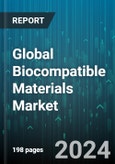Speak directly to the analyst to clarify any post sales queries you may have.
FPNV Positioning Matrix
The FPNV Positioning Matrix is pivotal in evaluating the Biocompatible Materials Market. It offers a comprehensive assessment of vendors, examining key metrics related to Business Strategy and Product Satisfaction. This in-depth analysis empowers users to make well-informed decisions aligned with their requirements. Based on the evaluation, the vendors are then categorized into four distinct quadrants representing varying levels of success: Forefront (F), Pathfinder (P), Niche (N), or Vital (V).Market Share Analysis
The Market Share Analysis is a comprehensive tool that provides an insightful and in-depth examination of the current state of vendors in the Biocompatible Materials Market. By meticulously comparing and analyzing vendor contributions in terms of overall revenue, customer base, and other key metrics, we can offer companies a greater understanding of their performance and the challenges they face when competing for market share. Additionally, this analysis provides valuable insights into the competitive nature of the sector, including factors such as accumulation, fragmentation dominance, and amalgamation traits observed over the base year period studied. With this expanded level of detail, vendors can make more informed decisions and devise effective strategies to gain a competitive edge in the market.Key Company Profiles
The report delves into recent significant developments in the Biocompatible Materials Market, highlighting leading vendors and their innovative profiles. These include 3 H Technology Institute, LLC, 3D Systems Corporation, Ashland Inc., BASF SE, Baxter International, Inc., Celanese Corporation, Covestro AG, DuPont de Nemours, Inc., Elix Polymers SLU, Ensinger GmbH, EOS GmbH, Evonik Industries AG, Formlabs Inc., Foster Corporation., Henkel AG & Co. KGaA,, Koninklijke DSM N.V., Kurt J. Lesker Company GmbH, Merck KGaA, Mitsubishi Chemical Corporation, Renishaw PLC, Sandvik AB, Shin-Etsu Chemical Co., Ltd., Stratasys Ltd., Stryker Corporation, and Wacker Chemie AG.Market Segmentation & Coverage
This research report categorizes the Biocompatible Materials Market to forecast the revenues and analyze trends in each of the following sub-markets:- Material Type
- Biocompatible Ceramic
- Biocompatible Metals
- Natural Polymers
- Synthetic Polymers
- End-use
- Academic & Research Institutes
- Pharmaceutical
- Region
- Americas
- Argentina
- Brazil
- Canada
- Mexico
- United States
- California
- Florida
- Illinois
- New York
- Ohio
- Pennsylvania
- Texas
- Asia-Pacific
- Australia
- China
- India
- Indonesia
- Japan
- Malaysia
- Philippines
- Singapore
- South Korea
- Taiwan
- Thailand
- Vietnam
- Europe, Middle East & Africa
- Denmark
- Egypt
- Finland
- France
- Germany
- Israel
- Italy
- Netherlands
- Nigeria
- Norway
- Poland
- Qatar
- Russia
- Saudi Arabia
- South Africa
- Spain
- Sweden
- Switzerland
- Turkey
- United Arab Emirates
- United Kingdom
- Americas
The report offers valuable insights on the following aspects
- Market Penetration: It presents comprehensive information on the market provided by key players.
- Market Development: It delves deep into lucrative emerging markets and analyzes the penetration across mature market segments.
- Market Diversification: It provides detailed information on new product launches, untapped geographic regions, recent developments, and investments.
- Competitive Assessment & Intelligence: It conducts an exhaustive assessment of market shares, strategies, products, certifications, regulatory approvals, patent landscape, and manufacturing capabilities of the leading players.
- Product Development & Innovation: It offers intelligent insights on future technologies, R&D activities, and breakthrough product developments.
The report addresses key questions such as
- What is the market size and forecast of the Biocompatible Materials Market?
- Which products, segments, applications, and areas should one consider investing in over the forecast period in the Biocompatible Materials Market?
- What are the technology trends and regulatory frameworks in the Biocompatible Materials Market?
- What is the market share of the leading vendors in the Biocompatible Materials Market?
- Which modes and strategic moves are suitable for entering the Biocompatible Materials Market?
Please note: For this report, the purchase of an Enterprise license allows up to ten worldwide users of an organization access to the report
Please note: This report can be updated on request. Please contact our Customer Experience team using the Ask a Question widget on our website.
With the purchase of this report at the Multi-user License or greater level, you will have access to one hour with an expert analyst who will help you link key findings in the report to the business issues you're addressing. This will need to be used within three months of purchase.
This report also includes a complimentary Excel file with data from the report for purchasers at the Site License or greater level.
Table of Contents
Companies Mentioned
- 3 H Technology Institute, LLC
- 3D Systems Corporation
- Ashland Inc.
- BASF SE
- Baxter International, Inc.
- Celanese Corporation
- Covestro AG
- DuPont de Nemours, Inc.
- Elix Polymers SLU
- Ensinger GmbH
- EOS GmbH
- Evonik Industries AG
- Formlabs Inc.
- Foster Corporation.
- Henkel AG & Co. KGaA,
- Koninklijke DSM N.V.
- Kurt J. Lesker Company GmbH
- Merck KGaA
- Mitsubishi Chemical Corporation
- Renishaw PLC
- Sandvik AB
- Shin-Etsu Chemical Co., Ltd.
- Stratasys Ltd.
- Stryker Corporation
- Wacker Chemie AG
Methodology

LOADING...
Table Information
| Report Attribute | Details |
|---|---|
| No. of Pages | 198 |
| Published | March 2024 |
| Forecast Period | 2024 - 2030 |
| Estimated Market Value ( USD | $ 13.51 Billion |
| Forecasted Market Value ( USD | $ 20.72 Billion |
| Compound Annual Growth Rate | 7.3% |
| Regions Covered | Global |
| No. of Companies Mentioned | 25 |









